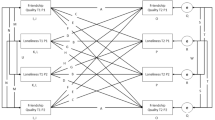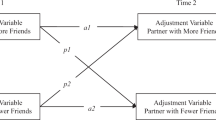Abstract
Peer relationships, particularly friendships, have been theorized to contribute to how children and adolescents think about social and moral issues. The current study examined how young adolescent best friends (191 dyads; 53.4 % female) reason together about multifaceted social dilemmas and how their reasoning is related to friendship quality. Mutually-recognized friendship dyads were videotaped discussing dilemmas entailing moral, social-conventional and prudential/pragmatic issues. Both dyad members completed a self-report measure of friendship quality. Dyadic data analyses guided by the Actor-Partner Interdependence Model indicated that adolescent and friend reports of friendship qualities were related to the forms of reasoning used during discussion. Friends who both reported that they could resolve conflicts in a constructive way were more likely to use moral reasoning than friends who reported that their conflict resolution was poor or disagreed on the quality of their conflict resolution. The findings provide evidence for the important role that friendship interaction may play in adolescents’ social and moral development.
Similar content being viewed by others
Notes
Dyads with one member being either high on withdrawn behavior (top 33 % on withdrawal and bottom 50 % on aggression), high on aggressive behavior (top 33 % on aggression and bottom 50 % on withdrawal), or low on both behaviors (bottom 50 % on withdrawal and aggression) were specifically targeted for participation in the laboratory portion of the study. Analyses indicated that individuals who came to the university-based laboratory did not differ from those who did not participate in the laboratory portion on indices of peer-nominated aggressive [t (1, 1459) = −.64, p = .52] or withdrawn behavior [t (1, 1459) = −1.59, p = .11] nor did the sample’s aggressive [t (377) = .49, p = .62] or withdrawn behavior [t (377) = 1.34, p = . 18] significantly differ from zero.
References
Banny, A. M., Heilbron, N., Ames, A., & Prinstein, M. J. (2011). Relational benefits of relational aggression: Adaptive and maladaptive associations with adolescent friendship quality. Developmental Psychology, 47, 1153–1166. doi:10.1037/a0022546.
Bowker, J. C., Fredstrom, B., Rubin, K. H., Rose-Krasnor, L., Booth-LaForce, C. L., & Laursen, B. (2010). Distinguishing children who form new best-friendships from those who do not. Journal of Social and Personal Relationships, 27, 707–725. doi:10.1177/0265407510373259.
Brendgen, M., Vitaro, F., Turgeon, L., & Poulin, F. (2002). Assessing aggressive and depressed children’s social relations with classmates and friends: A matter of perspective. Journal of Abnormal Child Psychology, 30, 609–624. doi:10.1023/A:1020863730902.
Bukowski, W. M., Hoza, B., & Boivin, M. (1994). Measuring friendship quality during pre- and early adolescence: The development and psychometric properties of the friendship qualities scale. Journal of Social and Personal Relationships, 11, 471–484. doi:10.1177/0265407594113011.
Cillessen, A. H. N., Jiang, X. L., West, T. V., & Laszkowski, D. K. (2005). Predictors of dyadic friendship quality in adolescence. International Journal of Behavioral Development, 29, 165–172. doi:10.1080/01650250444000360.
Daddis, C. (2008a). Influence of close friends on the boundaries of adolescent personal authority. Journal of Research on Adolescence, 18, 75–98. doi:10.1111/j.1532-7795.2008.00551.x.
Daddis, C. (2008b). Similarity between early and middle adolescent close friends’ beliefs about personal jurisdiction. Social Development, 17, 1019–1038. doi:10.1111/j.1467-9507.2008.00471.x.
Furman, W., & Buhrmester, D. (1992). Age and sex differences in perceptions of networks of relationships. Child Development, 63, 103–115. doi:10.1111/j.1467-8624.1992.tb03599.x.
Gasser, L., & Malti, T. (2012). Children’s and their friends’ moral reasoning: Relations to aggressive behavior. International Journal of Behavioural Development, 36, 358–366. doi:10.1177/0165025412448353.
Gottman, J. M., & Parker, J. G. (Eds.). (1987). Conversations of friends: Speculations on affective development. New York: Cambridge University Press.
Kandel, D. B. (1978). Homophily, selection, and socialization in adolescent friendships. American Journal of Sociology, 84, 427–436.
Kawabata, Y., & Crick, N. R. (2008). The role of cross-racial/ethnic friendships in social adjustment. Developmental Psychology, 44, 1177–1183. doi:10.1037/0012-1649.44.4.1177.
Keller, M. (1984). Resolving conflicts in friendship: The development of moral understanding in everyday life. In W. M. Kurtines & J. L. Gewirtz (Eds.), Morality, moral behavior, and moral development (pp. 140–158). New York: Wiley.
Keller, M. (2004). Self in relationship. In D. K. Lapsley & D. Narvaez (Eds.), Moral development, self, and identity (pp. 269–300). Mahwah: Lawrence Erlbaum.
Keller, M., & Wood, P. (1989). Development of friendship reasoning: A study of interindividual differences in intraindividual change. Developmental Psychology, 25, 820–826.
Keller, M., Edelstein, W., Schmid, C., Fang, F., & Fang, G. (1998). Reasoning about responsibilities and obligations in close relationships: A comparison across two cultures. Developmental Psychology, 34, 731–741. doi:10.1037/0012-1649.34.4.731.
Kelman, H. C. (1999). Transforming the relationship between former enemies: A social-psychological analysis. In R. L. Rothstein (Ed.), After the peace: Resistance and reconciliation (pp. 193–205). Boulder: Lynne Rienner.
Kenny, D. A., Kashy, D. A., & Cook, W. L. (2006). Dyadic data analysis. New York: Guilford.
Killen, M., & Rutland, A. (2011). Children and social exclusion: Morality, prejudice, and group identity. New York: Wiley/Blackwell.
Killen, M., & Stangor, C. (2001). Children’s reasoning about social inclusion and exclusion in gender and race peer group contexts. Child Development, 72, 174–186. doi:10.1111/1467-8624.00272.
Killen, M., Rutland, A., & Jampol, N. (2009). Social exclusion in childhood and adolescence. In K. H. Rubin, W. Bukowski, & B. Laursen (Eds.), Handbook of peer relationships, interactions, and groups (pp. 249–266). New York: Guilford Press.
Ladd, G. W. (1983). Social networks of popular, average, and rejected children in school settings. Merrill-Palmer Quarterly, 29, 283–307.
Laursen, B., & Pursell, G. R. (2009). Conflict in peer relationships. In K. H. Rubin, W. M. Bukowski, & B. Laursen (Eds.), Handbook of peer interactions, relationships, and groups (pp. 267–286). New York: Guilford.
Malti, T., & Buchmann, M. (2010). Socialization and individual antecedents of adolescents’ and young adults’ moral motivation. Journal of Youth and Adolescence, 39, 138–149. doi:10.1007/s10964-009-9400-5.
Malti, T., Killen, M., & Gasser, L. (2012). Social judgments and emotion attributions about exclusion in Switzerland. Child Development, 83, 697–711. doi:10.1111/j.1467-8624.2011.01705.x.
Marrow, D. (1999). Seeking peace amid memories of war: Learning form the peace process in Northern Ireland. In R. L. Rothstein (Ed.), After the peace: Resistance and reconciliation (pp. 111–138). Boulder: Lynne Rienner Publishers.
McDonald, K. L., Putallaz, M., Grimes, C. L., Kupersmidt, J. B., & Coie, J. D. (2007). Girl talk: Gossip, friendship, and sociometric status. Merrill Palmer Quarterly, 53, 381–411. doi:10.1353/mpq.2007.0017.
Mendelson, M. J., & Kay, A. C. (2003). Positive feelings in friendship: Does imbalance in the relationship matter? Journal of Social and Personal Relationships, 20, 101–116. doi:10.1177/02654075030201005.
Moller, L. C., Hymel, S., & Rubin, K. H. (1992). Sex typing in play and popularity in middle childhood. Sex Roles, 26, 331–353.
Nucci, L. P. (2001). Education in the moral domain. New York: Cambridge University Press.
Oh, W., Rubin, K. H., Bowker, J. C., Booth-LaForce, C. L., Rose-Krasnor, L., & Laursen, B. (2008). Trajectories of social withdrawal from middle childhood to early adolescence. Journal of Abnormal Child Psychology, 36, 553–556.
Parker, J. G., & Asher, S. R. (1993). Friendship and friendship quality in middle childhood: Links with peer group acceptance and feelings of loneliness and social dissatisfaction. Developmental Psychology, 29, 611–621. doi:10.1037/0012-1649.29.4.611.
Piaget, J. (1932). The moral judgment of the child. London: Kegan Paul.
Preacher, K. J., Curran, P. J., & Bauer, D. J. (2006). Computational tools for probing interaction effects in multiple linear regression, multilevel modeling, and latent curve analysis. Journal of Educational and Behavioral Statistics, 31, 437–448. doi:10.3102/10769986031004437.
Rose, A. J., Carlson, W., & Waller, E. M. (2007). Prospective associations of co-rumination with friendship and emotional adjustment: Considering the socioemotional trade-offs of co-rumination. Developmental Psychology, 43, 1019–1031. doi:10.1037/0012-1649.43.4.1019.
Rubin, K. H., Bukowski, W., Parker, J. G. (2006). Peer interactions, relationships, and groups. In W. Damon, R. M. Lerner, & N. Eisenberg (Eds.), Handbook of child psychology: Vol. 3, Social, emotional, and personality development (6th ed., pp. 571–645). New York: Wiley.
Rubin, K. H., Fredstrom, B., & Bowker, J. (2008). Future directions in friendship in childhood and early adolescence. Social Development, 17, 1085–1096. doi:10.1111/j.1467-9507.2007.00445.x.
Rubin, K. H., Bowker, J. C., McDonald, K. L., & Menzer, M. (2013). Peer relationships. (pp. 242–275). In P. Zelazo (Ed.), Oxford handbook of developmental psychology. Oxford: Elsevier.
Schonert-Reichl, K. A. (1999). Relations of peer acceptance, friendship adjustment, and social behavior to moral reasoning during early adolescence. The Journal of Early Adolescence, 19, 249–479. doi:10.1177/0272431699019002006.
Selman, R. L. (1980). The growth of interpersonal understanding. New York: Academic Press.
Smetana, J. G. (1999). The role of parents in moral development: A social domain analysis. The Journal of Moral Education, 28, 311–321.
Smetana, J. G. (2006). Social domain theory: Consistencies and variations in children’s moral and social judgments. In M. Killen & J. G. Smetana (Eds.), Handbook of moral development (pp. 119–154). Mahwah: Erlbaum.
Smetana, J. G. (2011). Adolescents, families, and social development: How teens construct their worlds. NY: Wiley/Blackwell.
Smetana, J. G., & Asquith, P. (1994). Adolescents’ and parents’ conceptions of parental authority and personal autonomy. Child Development, 65, 1147–1162. doi:10.1111/j.1467-8624.1994.tb00809.x.
Spencer, S. V., Bowker, J. C., Rubin, K. H., & Booth-LaForce, C. L. (2013). Similarity between friends in social information processing and associations with positive friendship quality and conflict. Merrill-Palmer Quarterly, 59, 106–134. doi:10.1353/mpq.2013.0006.
Sullivan, H. S. (1953). The interpersonal theory of psychiatry. New York: Norton.
Turiel, E. (2006). The development of morality. In N. Eisenberg (Ed.), W. Damon (Series Ed.), Handbook of child psychology: Vol. 3. Social, emotional, and personality development (6th ed., pp. 789–857). New York: Wiley.
Walker, L. J. (2006). Gender and morality. In M. Killen & J. Smetana (Eds.), Handbook of moral development (pp. 93–118). Mahwah: Lawrence Earlbaum.
Walker, L. J., & Taylor, J. H. (1991). Family interactions and the development of moral reasoning. Child Development, 62, 264–283. doi:10.1111/j.1467-8624.1991.tb01530.x.
Wojslawowicz, J. C., Rubin, K. H., Burgess, K. B., Rose-Krasnor, L., & Booth-LaForce, C. L. (2006). Behavioral characteristics associated with stable and fluid best friendship patterns in middle childhood. Merrill-Palmer Quarterly, 52, 671–693. doi:10.1353/mpq.2006.0000.
Acknowledgments
The authors would like to thank Linda Finkel and Michael Schlessinger for help with coding and transcriptions. The authors would also like to thank the children, parents, and teachers who participated in the study, as well as Julie Bowker, Allison Buskirk-Cohen, Angela Chiang, Ebony Dashiell-Aje, Kathleen Dwyer, Erin Galloway, Jon Goldner, Sue Hartman, Amy Kennedy Root, Angel Kim, Sarrit Kovacs, Melissa Menzer, Alison Levitch, Abby Moorman, Wonjung Oh, Andre Peri, Margro Purple, Joshua Rubin, Erin Shockey, and Alissa Wigdor who assisted in data collection and input. The research reported in this manuscript was supported by National Institute of Mental Health grant # MH58116 to Kenneth H. Rubin. Kristina L. McDonald was a Post-doctoral Fellow at the University of Maryland with Kenneth Rubin during the formulation of this study.
Author Contributions
K.M. conceived of the study, participated in the design, performed the statistical analyses, interpreted findings, and drafted the manuscript; T.M. conceived of the study, participated in the design, led data coding, and helped to draft the manuscript; M.K. participated in the design, interpreted findings, and helped to draft the manuscript; K.R. conceived of the larger study, participated in design and data collection, interpreted findings, and helped to draft the manuscript. All authors read and approved the final manuscript.
Author information
Authors and Affiliations
Corresponding author
Rights and permissions
About this article
Cite this article
McDonald, K.L., Malti, T., Killen, M. et al. Best Friends’ Discussions of Social Dilemmas. J Youth Adolescence 43, 233–244 (2014). https://doi.org/10.1007/s10964-013-9961-1
Received:
Accepted:
Published:
Issue Date:
DOI: https://doi.org/10.1007/s10964-013-9961-1




